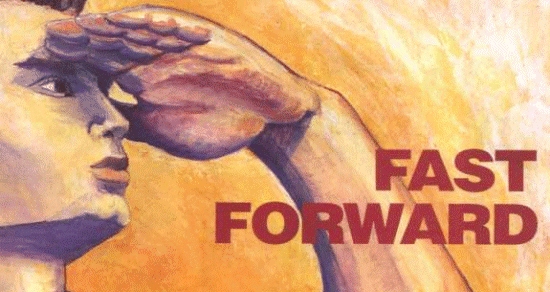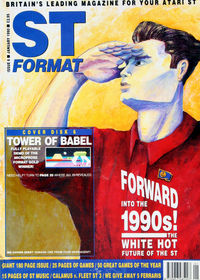
The ST's future promises power
"The ST can, and will, stand on its own two feet against any other machine - including the Apple Mac. The future lies in the Mega ST side of the business, an area where the machine as enormous potential"
Mike Dale, Signa Publishing
- but the future is also upwardly compatible:
"[The TT] has an open architecture, allowing the second or third time buyer an upgrade path to a machine they can expand... And as for the STE, I'm not concerned about programmers not taking advantage of its enhancements. The STFM market is now large enough that people will keep writing for it. Because the STE is fully STFM compatible, more software will exploit its features there'll be a crossover"
Bob Gleadow, Atari UK
When the ST was first launched at the January 1985 CES Show, one could reasonably argue it marked the end of the term "home micro." Here was a "personal computer" - admittedly a collection of boxes comprising a keyboard and processing unit, disk drive and power supply - but a "system" nevertheless. All this baby needed to reach maturity was a world of software.
Its growth was assured - it had a better spec than the only other friendly machine on the block, the Mac, and it was a darned sight cheaper. As for the PC - well MS-DOS was a joke even then. The ST set out to meet our expectations by realising our dreams. 256 colours, half a meg of RAM, WIMPS front-end it all sounds so hackneyed now, but five years is an eternity in computing. So much so, that despite claimed sales of 1.5 million, Atari appears to believe it's time to move on. STEs, TTs, RISC based 68040s - they're all on the cards to change your ST as you know it. But it's not because the ST is suddenly out of date it's because the ST has encouraged our demands for even better Atari products.
LAUNCH 'N' LISTEN
Atari has always had a policy of launching then listening. If you visited the British PCW show some nine months after CES 85 you'd have found a basic 520 ST with TOS on disk that would have cost you_ £749.99. And if you'd known anything about Atari you wouldn't have touched it with a barge pole. They're a company that doesn't stand still. They have the kind of corporate philosophy which states, "If there's any advancement to be had, it should have an Atari logo." And what's more it should be affordable - there's no point bringing out an Archimedes if you can't shout "Eureka!" at the wealth of software and peripherals available for it.
Low manufacturing prices encourage publishers, publishers encourage distributors, distributors encourage third party manufacturers. The wheel comes full circle. Before you know it you have a machine within a machine. You have Elmtech producing the Parsec graphics board which addresses 16.7 million colours. And you have Atari going back to the drawing board, content with its marketing strategy.
But back in February '86, you would have only seen this "Power Without The Price" policy bringing you the STM - an upgrade with TV modulator and TOS in ROM. However, in less than a month there was the STFM with all the hardware in a single box and by the next PCW Show there was a 1040 and Mega ST2 and 4 models.
So was this the time to buy? February '87 saw STFMs for £399: six months later they were available for £299. In less than two years the machine had carved out a market and was making heavy inroads into the future. September '87 also saw another pointer to the future for an extra £1 00 you could get an ST with £500 of bundled software. That deal is still going. But is the momentum?
A COOL MILLION
We're now on the brink of the 90s and there's a million STs in the world - Sam Tramiel reckons on 1.5 million - half of them in Germany alone. Most of these are 1040s or Megas, which explains the presence of companies like Signa, GFA and G5T - all geared towards producing professional software for professional applications.
There are around 160,000 STs in the UK and about the same number in France but at the moment only some 10-15,000 using Megas for DTP work and program development. So the massive worldwide user base is multi-layered there's no predominant type of use, no typical 5T user. The beauty of the ST is that you can run a sophisticated DTP package, output your work to laser and linotype bureau, produce raytrace animations, record a 99 track synthesised extravaganza and cut some TV titles - all in the one evening.
With the appearance of stereo sound boards like the Tweety, enhanced graphics cards like the Parsec, genlocks, CD-ROM players, Mac and PC emulators and, of course, state of the art shoot-'em-ups, the only limit to your imagination is your bank balance.
For what we're looking at is a system platform - a base from which a whole host of TOS compatible machines can launch into the 90s, machines assured of running all our current software and peripherals. So the S1's longevity is secured. After all, a million machines is a very solid platform. But how do all the new announcements and developments fit into the ST future?
The ST range is ideally placed to meet the wider, and Quite often conflicting, demands of general personal computing: pleasure, of course, with greatly improved gameplay; but also factors such as increased portability, compatibility, specialisation, and power. But above all power.
THE FUTURE IS POWER
"We want the guy with real buying power" - Bob Gleadow, Atari UK
With a choice of screen resolutions, monochrome at 1280x960 and colour at both 640x480 and 320x480, the 2MByte TT steams along at 16Mhz on a 68030 chip and provides, as Gleadow is only too Quick to point out, "an open architecture... allowing the second or third time buyer an upgrade path to a machine they can expand... its initial market will be in universities as a very fast workstation, as text and graphics engine."
But Atari want more than that. Gleadow's on record as saying he wants the "high-end of the workstation market." And that means RISC. The most likely contender here, and one that various Atari spokesmen have hinted at this year, is a TOS compatible 68040 machine. Expect to see it by 1992.
The recently launched TT has three modes of operation - ST TOS 1.4, MS-DOS and Unix 5.31, making it downwardly compatible with the ST, horizontally compatible with the PC and to a degree future-proof with Unix.
THE FUTURE IS COMPATIBILITY
"Windows is the key - it's the serious interface... the opera tine system of the future" - lan Rhyll, Digita International
Rhyll is not exaggerating, and that's why there's a plethora of PC emulators already beginning to appear for the ST. The latest, Supercharger, claims to run faster than a PC 286. For whether you like it or not, the IBM PC compatible standard is important to the whole future of computing - otherwise Atari wouldn't be pushing its Folio and PCs so strongly. Sales of PC Ditto and PC Speed are also reported to be very healthy.
So does that mean we shall see Atari releasing an ST with a built-in bridgeboard in the next two years? Probably not. It's more likely to go for a version of GEM that can co-exist with a Windows front-end supplied by the next wave of third party emulators.
THE FUTURE IS SPECIALISATION
"The future lies in the Mega ST side of the business where the machine has enormous potential for Desktop Publishing, Local Area Networking, Desktop Video, hi-res scanning and high-class word processing. More and more companies are looking at ways of networking a good DTP machine that has possibilities such as optical character recognition" - Mike Dale, Signa
And you can be sure Signa will be spearheading those developments in years to come. From its Calamus Desk Top Publishing system (reviewed in this issue; feature starting page 82 ) to its Chilli Desktop Video system, it's done more than most to pioneer the ST as a professional platform.
With the increased portability, compatibility and power supplied by new ST hardware and third-party add-ons, the future of the ST as a personal workstation is assured - and that's before you start to bring 68030 and 040 chips into the picture. Such advances open up the ST platform for even more sophisticated operations, such as multimedia where the machine can shortly be expected to act as a controlling device for desktop presentation and interactive training.
Drivers and front-ends to combine laserdisks, CD-RaMs, professional video machines and slide generators are already available for the Mac and Amiga. Now the ST has a working genlock, the unifying device (see the review of Gold, imported by Third Coast, in last month's ST Format), you can expect multimedia software to start appearing in the next year.
THE FUTURE IS PORTABILlTY
£1500 will buy you one of the three versions of the Stacy portable running TOS 1.4 on a 8 MHz 68000 with 256K ROM and up to 4MBytes of RAM. With a 20MByte hard disk for storage, a Supertwist monochrome 640x400 lCD screen, 3.5 inch DD disk drive and serial, parallel, and MIDI ports, the Stacy would seem ideal for the pro on the move - whether s/he's a writer, musician or business person. With a cartridge slot for a Mac or PC emulator you have a versatile, mobile ST that's a pointer of things to come
THE FUTURE IS PLEASURE
last but not least, what can we expect in the leisure department? Even if Gleadow and Dale are right in their guesses about where the ST/STE/TT is headed - ie, up - there will always be a need for entertainment software. Indeed the PC world is experiencing an explosion of games. Atari realise this, for their assault on the games world, ARC, is aiming to cream some of the vast rewards yet to be had in the Amiga, PC and ST markets. A machine can be powerful and fun at the same time.
Yet many owners of singled-sided STs and even 1040s are beginning to worry. With the announcement of the 1040STE and at November's Comdex Show of the 520STE, they wonder whether they have bought into obsolete equipment. Not a bit of it.
Although the machine has a 4,096 colour palette, four channel stereo and multi-directional hardware scrolling, it still runs off a 8 MHz 68000, so it's 100% compatible with the current ST. Bob Gleadow represents Atari's careful thinking on its future when he admits, "It's intended to replace the 1040 and as such is priced identically... I'm not unduly concerned about programmers not taking advantage of the STE's enhancements,- the STFM market is now large enough so that people will keep writing for it. Because the STE is fully STFM compatible, more and more software will exploit its new features, there'll be a crossover."
Reading between the lines it's fairly obvious that Atari are determined that the ST should not go the way of the Spectrum, the Commodore 64 and the Amstrad CPC - it needs to remain on top of current developments, not get left behind by them. On the other hand they realise that a million customers can't be wrong.
The answer is upward compatibility, allowing programmers to take advantage of new enhancements while they continue to service their existing customers.
So how might games programmers set about exploiting its features? Very briefly we can expect Solid 3D to become ray-traced 3D and spot-effect sound to be sampled in stereo. In the longer term we'll see greater screen handling open up areas such as colourful Disney-style animation, and simulations will benefit from more detailed reality.
THE SOUND OF THE FUTURE
We asked ST Format's new music editor, Jon Bates, to hazard a few guesses about the ST's musical future
While today's ST is certainly no slouch at playing back sampled sounds, it's not what you might call Mr Fabulous at actually synthesizing them. The much-vaunted upgraded ST, the STE, does offer a little more than the ST in sonic terms. Although it has had to retain the original sound chip to maintain compatibility, It has been awarded two additional hardware features. One is a dedicated tone, volume and mixing chip, and the other is the ability to read and convert digital samples from the memory directly without involving the 68000 processor. It is disappointing, however, that the sampling rates are set at four predetermined speeds. This is bad news for sampling program producers, because to get a succession of variable sample rates some fairly intensive maths (sums - yeugh!) will be involved.
The bottom line is probably that although -the new, cleaner method of reproducing sampled stereo sound will be used in dedicated sampling routines, for the likes of game soundtracks you're going to be asked which machine you are running on. The ST will perform as ever and the STE will have a greater spectrum of sounds, probably mixing sounds from the old sound chip with the samples in the memory thanks to the volume, tone and mixing chip. An improvement, but not a radical step forward as a program may well need two independent sampling and sound playing routines.
BREEDING LIKE RABBITS
The half-way house is to offer a package that consists of a bolt-on dedicated sound chip (see ST Format 4 for review of Hybrid Arts FM Melody Maker). These are good value for money, but they are usually made up from surplus sound chips nearing the end of their marketable life from synth and single keyboard manufacturers. One or two more of these might well surface in 1990.
MIDI "Musical Environment" programs are definitely on the horizon. These will have several MIDI programs co-existing at the same time and interacting with each other. This is already happening with software from C-Lab, Steinberg, Hybrid Arts and Doctor T with a trend, thank goodness, towards making the compatibility extend beyond their own software. There IS not much point In having compatible software If you are tied to one software developer.
Of course this eats into the memory, and the 520ST won't really get a look-in. The italicised small print reminds one that at least 2MBytes is required for serious work. Perhaps this heralds a price reduction In the multi MByte machines, as they start to sell In larger quantities.
Another major trend IS the universal editor. Synths are usually launched, followed, after Suitable development time, by editing software. Thanks to MIDI your favorite synth is no longer obsolete but can be augmented by newer synths with totally different internal architecture and sound creating methods.
Nowadays to keep up to date you would need a veritable suite of software to program all the synths - each one with ItS own library. The result is a time consuming set-up and re-booting session each time you start. Since different revamped synths pour out onto the market with a gestation period similar to rabbits, software developers find It hard to keep up and the public at large can't be bothered to buy it anyway.
Enter the universal editor and sound librarian, a program that can adapt itself to pretty well any synth once a set of instructions has been set up to allow It to work with the synth of your choice.
COVER DISK: LET'S HEAR IT FOR THE ST!
If, like many readers, you're relatively new to the idea of the ST as a music controller, get our Cover Disk loaded up and give the demo of Replay Professional a good going over. This brilliant sampling program is reviewed on page 125.
One thing it cannot do, however, is transfer sound from one synth to another - that would be asking too much! Expect to see lots of these soon at prices varying from well under £1 00 for the librarian, to about £200 plus for the full blown editor.
UNIVERSAL CHALLENGE
As well as universal synth editors, you can expect to see more universal sample editors, Which will perform tricks like taking data from a CD, editing It and preparing It for a wide range of dedicated samplers. This is really getting towards the professional end of the market and IS available on Sternberg s Avalon program. It IS, though, an exciting thought that, armed with a dedicated high quality sampler - Cheetah are due to launch one at under £800 - you could reproduce the sound of any synth simply by sampling it!
On the down side of all this is the failure of MIDI time code to have taken off. This was to be a universal time code that would link sequencers, videos, reel-to-reel tape recorders and some four-track cassette machines, thus replacing the expensive hardware required for SMPTE, the current synchronizing system. The failure of any agreement between soft and hardware developers has, unfortunately, left this cheaper option well aground for the moment, which is where it looks like staying.
Finally, what would be terrific would be more routines to convert the MIDI exclusive data that comprises the sound of one synth, directly into MIDI sample data. This was done with the X-Alyser from C-Lab a year or two ago, but no-one seems to have taken the Initiative. Maybe this year, chaps?.
Turn to page 109 for an ST Format music special - 15 pages packed full of software reviews as well as a clutch of interviews with top bands who use the ST



